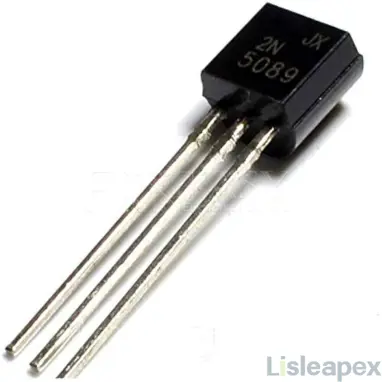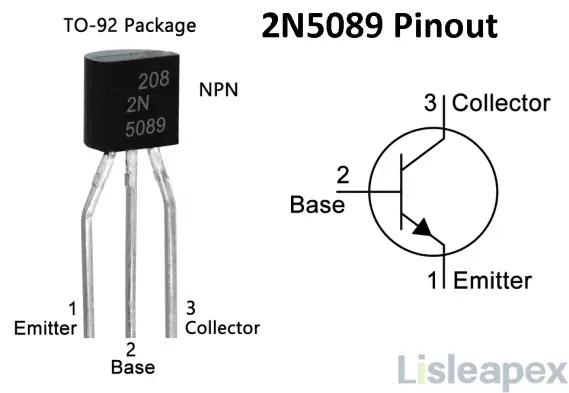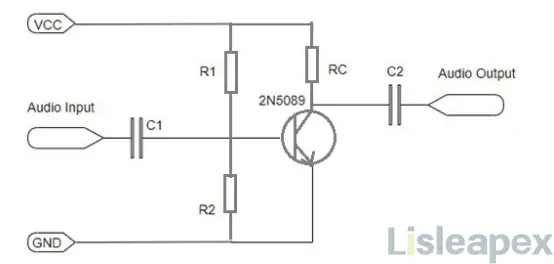2N5089 Transistor Description
The 2N5089 transistor is a small-signal, general-purpose NPN BJT. It is housed in a TO-92 package, a through-hole style widely used in various electronic applications. This transistor is characterized by its moderate collector-emitter voltage (VCE) and collector current (IC) ratings, making it suitable for low-power amplification tasks.

- 2N5089 - NPN Transistor
- Price: $0.32
- Current stock: 20000
- Package: TO-92
- Datasheet Download
Advantages
- Suitable for low-side switching. Similarly, PNP transistors can be used in any application requiring high-side switching.
- Supports 25V collector-to-emitter breakdown voltage and 30V collector-to-emitter breakdown voltage.
- Operates at up to 50mA continuous collector current.
- Provides high hFE and is therefore used in specific audio-related products or for audio amplification
2N5089 Transistor Pinout

Pin Configuation
|
Pin Number |
Pin Name |
Description |
|
1 |
Emitter |
Emitter pin of the transistor |
|
2 |
Base |
Base pin of the transistor |
|
3 |
Collector |
Collector pin of the transistor |
2N5089 Features and Specifications
|
Attribute |
Details |
|
Manufacturer |
Central Semiconductor |
|
Product Category |
Bipolar Transistors - BJT |
|
RoHS |
Details |
|
Mounting Style |
Through Hole |
|
Package / Case |
TO-92 |
|
Transistor Polarity |
NPN |
|
Configuration |
Single |
|
Collector-Emitter Voltage VCEO Max |
25 V |
|
Collector-Base Voltage VCBO |
30 V |
|
Emitter-Base Voltage VEBO |
4.5 V |
|
Collector-Emitter Saturation Voltage |
500 mV |
|
Maximum DC Collector Current |
50 mA |
|
Power Dissipation (Pd) |
625 mW |
|
Gain Bandwidth Product fT |
50 MHz |
|
Minimum Operating Temperature |
-65°C |
|
Maximum Operating Temperature |
+150°C |
|
Packaging |
Bulk |
|
Brand |
Central Semiconductor |
|
Continuous Collector Current |
50 mA |
|
DC Collector/Base Gain hfe Min |
400 |
|
DC Current Gain hFE Max |
1200 |
|
Product Type |
BJTs - Bipolar Transistors |
|
Subcategory |
Transistors |
|
Unit Weight |
0.016000 oz |
Key Features of 2N5089
- NPN Bipolar Transistor: It belongs to the NPN category of transistors, facilitating amplification and switching functions.
- Low Power: Typically designed for low-power applications due to its moderate collector current and power dissipation capabilities.
- Medium Frequency: Suited for applications in the medium-frequency range due to its transition frequency (fT) specifications.
- General-Purpose Amplification: Widely used for general-purpose amplification in various electronic circuits.
- TO-92 Package: The transistor is encapsulated in a TO-92 package, a widely used through-hole package style.
- Moderate Collector Current and Voltage Ratings: With a moderate collector-emitter voltage (VCE) and collector current (IC) ratings, it's suitable for a range of smaller-scale electronic projects.
- Good DC Current Gain Range: Offers a relatively wide range of DC current gain (hFE), making it versatile for different amplification needs.
- Temperature Range: Operates within a moderate temperature range, making it suitable for various environmental conditions.
2N5089 HFE
The 2N5089 transistor typically has a DC current gain (hFE) ranging from approximately 400 to 1200 under specific test conditions, such as VCE=5.0V and IC=0.1mA. This range might vary slightly between individual transistors due to manufacturing tolerances and environmental factors.
More Electrical characteristics for the 2N5088 and 2N5089 transistors under test conditions at 25°C
ICBO (Collector Cut-off Current):
VCB=20V: 50nA (maximum)
VCB=15V: 50nA (maximum)
IEBO (Emitter Cut-off Current):
VEB=3.0V: 50nA (maximum)
VEB=4.5V: 100nA (maximum)
BVCBO (Collector-Base Breakdown Voltage):
IC=100μA: 35V (minimum) for 2N5088, 30V (minimum) for 2N5089
BVCEO (Collector-Emitter Breakdown Voltage):
IC=1.0mA: 30V (minimum) for 2N5088, 25V (minimum) for 2N5089
VCE(SAT) (Collector-Emitter Saturation Voltage):
IC=10mA, IB=1.0mA: 0.5V (maximum)
VBE(ON) (Base-Emitter On Voltage):
VCE=5.0V, IC=10mA: 0.8V (maximum)
hFE (DC Current Gain):
VCE=5.0V, IC=0.1mA: 300 to 900 for 2N5088, 400 to 1.2K for 2N5089
VCE=5.0V, IC=1.0mA: 350 for 2N5088
VCE=5.0V, IC=10mA: 300 for 2N5088
hfe (Small Signal Current Gain):
VCE=5.0V, IC=1.0mA, f=1.0kHz: 350 to 1.4K for 2N5088, 450 to 1.8K for 2N5089
fT (Transition Frequency):
VCE=5.0V, IC=0.5mA, f=20MHz: 50MHz (typical)
Cob (Output Capacitance):
VCB=5.0V, IE=0, f=100kHz: 4.0pF (maximum)
Cib (Input Capacitance):
VEB=0.5V, IC=0, f=100kHz: 15pF (maximum)
NF (Noise Figure):
VCE=5.0V, IC=100μA, RS=10kΩ, f=10Hz to 15.7kHz: Between 3.0 to 2.0dB (maximum)
2N5089 Transistor Circuit
Typically, most body tubes are used as switches and amplifiers. In this typical application circuit, the 2N5089 transistor used as an amplifier will be briefly described. The circuit is mainly designed in a common emitter configuration and since this configuration contains high gain, this circuit is mainly used to amplify signals.

In the circuit above, it shows how the 2N5089 transistor is connected in an audio device. The combining capacitor is 'C1, the isolation capacitor is C2 and the collector resistor is RC, once its value is changed, the frequency response of the circuit will change and the DC gain collector current will be controlled by controlling CC. The resistors R1 and R2 used in the above circuit act like voltage dividers for biasing the transistors.
Once the audio input signal is supplied to the base terminal of the transistor, some voltage is supplied to the collector terminal of the transistor to turn on the active mode, so this transistor is used as an amplifier.
Moreover, the audio input signal in the above circuit is an AC signal. The main role of the coupling capacitor in the circuit is to avoid distortion of the signal, which would otherwise exhibit high i/p impedance for fewer frequency components, thus affecting the audio quality.
A capacitor is connected in series with the output to block unwanted DC components. Here, the RC resistor is used to control the current flow at the collector end and hence the gain of the amplifier. Thus it is responsible for the frequency response of the circuit and the weak radio signal flowing through the NPN transistor is amplified and this amplified signal is used in low noise and audio amplification based systems.
Application of 2N5089
You could find the application of 2N5089 in various electronic circuits for amplification and switching purposes as below,
- For amplifier systems
- Switching loads below 100mA
- For high fidelity audio systems
- RF circuits up to 50MHz
- Audio preamplifiers, tone controls
- For switch-based applications
- Sensor-based circuits
- Radio circuits
- Miscellaneous signal amplification
- Signal Modulation
- Noise Amplification Based Systems
- High autofocus systems
- Temperature Detection Systems
- Push-pull circuits
2N5089 Equivalent Part
The equivalent part of 2N5089 transistor includes MMBT5089, NTE128, PN5089 and BC238.
The replacements for this transistor are MPS650, MPS6532, MPSH10.
2N5089 vs 2n5088:What are Main Differences and How to Choose
The 2N5088 and 2N5089 transistors are quite similar in many aspects:
- Type: Both are NPN small-signal bipolar junction transistors (BJTs) used for amplification and switching purposes in electronic circuits.
- Package: They often come in the same TO-92 package, which is a common through-hole package style.
- Applications: Both are suitable for various low-power applications requiring moderate amplification.
However, there are some key differences:
hFE Range: The primary difference lies in their DC current gain (hFE) characteristics. The 2N5088 typically has an hFE range of 300 to 900, while the 2N5089 typically ranges from approximately 400 to 1200. This indicates that the 2N5089 tends to have a higher amplification capability.
Specific Electrical Characteristics: Although they share similarities, there might be slight variations in other electrical characteristics such as breakdown voltages (BVCEO and BVCBO) and other parameters under certain test conditions.
When Choosing Between the 2N5088 and 2N5089:
- hFE Requirement: If your circuit design demands a specific range of hFE values, consider selecting the transistor that best fits within that range. The 2N5089 generally offers a higher hFE range compared to the 2N5088.
- Application Needs: Evaluate the specific requirements of your circuit. If your application benefits from higher amplification capabilities, the 2N5089 might be more suitable.
- Datasheet Verification: Always refer to the datasheets of these transistors to understand their electrical characteristics, performance under different conditions, and suitability for your application.
In summary, the choice between the 2N5088 and 2N5089 hinges on your circuit's specific requirements, particularly in terms of the desired DC current gain (hFE) range and other electrical characteristics necessary for optimal performance in the intended application.
2N5089 Manufacturer
Central Semiconductor Corp. is a manufacturer of discrete semiconductors, specializing in innovative solutions for various industries. They produce a wide range of discrete semiconductors, including diodes, transistors, rectifiers, MOSFETs, and more. Central Semiconductor is known for its focus on delivering high-quality, reliable components and providing engineering support to customers for their diverse electronic applications. Their products often cater to automotive, communications, consumer electronics, industrial, and other sectors requiring semiconductor solutions.
FAQ
-
Can the 2N5089 transistor be replaced with another transistor?
Depending on the specific application and circuit requirements, other transistors with similar characteristics, such as the 2N3904 or BC547, might be used as substitutes for the 2N5089.
-
What precautions should be considered when using the 2N5089 transistor?
Ensure the operating conditions (voltage, current) remain within the specified limits to prevent damaging the transistor. Proper biasing and heat dissipation measures should also be considered.
-
Is the 2N5089 transistor suitable for switching applications?
Yes, the 2N5089 transistor can be used in low-power switching applications due to its moderate current-handling capabilities.
-
Is the 2N5089 transistor suitable for high-frequency applications?
While the 2N5089 has a moderate transition frequency (ft) of around 200MHz, it might not be the best choice for very high-frequency applications due to its limited bandwidth.
Stay updated with Lisleapex by signing up for the newsletter


 Congratulations On Your Successful Submission
Congratulations On Your Successful Submission
 Submission Failure
Submission Failure